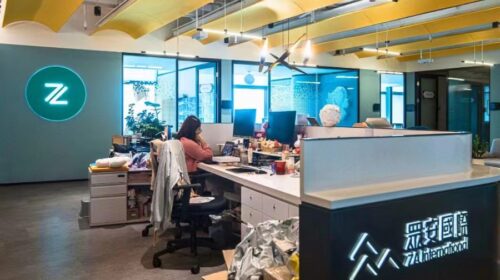ZhongAn Moves Further Out of Parental Shadow as Tencent Cuts Stake

Two of the digital insurer’s three big-name parents have trimmed their stakes recently, highlighting the need for company to grow independently
Key takeaways:
• Tencent reduced its stake in ZhongAn to about 8% from 10%, less than six months after Alibaba-affiliated Ant Group also cut its stake in the online insurer
• ZhongAn’s net profit more than doubled last year, as reliance on its parents for business has decreased
By Warren Yang
By accident or design, it’s about time for ZhongAn Online P&C Insurance Co. Ltd. (6060.HK) to shine on its own, outside the shadow of its big-name founders.
The online insurer got a gentle nudge out of the nest last week when one of its founders, a subsidiary of internet giant Tencent (0700.HK), cut its stake in the company to about 8% from 10%, according to a filing last Friday. Tencent owned 15% of ZhongAn when it co-founded the venture in 2013, together with Alibaba (BABA.US; 9988.HK)-affiliated Ant Group and Ping An Insurance (2318.HK; 601318.SS). Then, Tencent’s stake was diluted to about 10% after ZhongAn issued new shares to go public in Hong Kong in 2017.
Tencent’s move comes less than six months after Ant also reduced its stake in ZhongAn to about 10% from 14%. When Ant scaled back its ZhongAn stake at the start of this year, investors apparently interpreted the move to represent a weakening of ties between the two and sent ZhongAn stock sharply down, prompting Ant to issue a statement to calm their nerves.
There was no such drama for ZhongAn’s stock this time around. Maybe that’s because investors have learned that no incremental changes in the company’s relationships with its three parents will make or break its business. Underscoring that point, ZhongAn posted stellar results for last year, even as it reduced its reliance on the trio for revenue generation.
The sell-down by first Ant and now Tencent comes as Chinese authorities have grown wary over big tech becoming too powerful. That concern first went on prominent display in late 2020, when Beijing scuttled Ant’s massive $34 billion IPO in Shanghai and Hong Kong at the 11th hour.
That shock development was just a beginning. A broader crackdown on big tech ensued, with the Communist Party’s discipline agency urging authorities to “show no mercy” in rooting out corruption linked to the “disorderly expansion of capital.”
Against this backdrop, Tencent, like Ant and other Chinese tech titans, has been under pressure to divest its huge portfolio of non-core assets. The WeChat owner has sold most of its stake in JD.com Inc. (JD.US), the second largest online retailer in China, and trimmed its ownership in Sea, the largest internet company in Southeast Asia.
Such cord-cutting has been unnerving to investors, who may see the loosening of equity ties as a red flag due to perceived reliance by smaller companies like ZhongAn on their massive and highly influential big stakeholders.
ZhongAn made a name for itself in its early years by selling insurance to cover costs for returning goods sold on Taobao, Alibaba’s C2C online shopping service. The insurer continues to rely on Alibaba platforms to sell its products under a cooperation agreement. Similarly, ZhongAn sells various products through Tencent’s WeBank online bank, though on a much smaller scale than the collaboration with Alibaba. Additionally, ZhongAn sells insurance to employees of two Tencent companies.
Increasing independence
But ZhongAn is also becoming increasingly independent, diversifying its products and developing its own distribution channels. Fees paid by ZhongAn to all of its third-party platform partners, including Alibaba and Tencent, decreased to 23.5% of net written premiums last year from 26.5% in 2020. This helped ZhongAn turn its first-ever annual profit from insurance underwriting last year, meaning there was money left over from premiums it collected for the year after all costs and claim payouts were deducted.
ZhongAn also collaborates with its financial heavyweight parent, Ping An, for asset management services. Under a deal that has been renewed every two years, ZhongAn pays Ping An to manage part of its assets.
But similar to its growing independence in insurance sales, ZhongAn has also been beefing up its own investment capability, gradually cutting itself loose from Ping An. ZhongAn’s investment income jumped 66% last year, while asset management fees it paid Ping An amounted to just under 40% of the annual cap for such transactions under the cooperation agreement between the two, down from about 68% in 2020.
A combination of the underwriting profit, though small, and the nice investment performance led to a more than doubling of ZhongAn’s net profit last year.
The insurer is also branching out of insurance, with some success. Its Za Bank, which was created in 2019 as one of the first digital-only banks in Hong Kong, is growing fast and boasted more than half a million customers in a city with a population of fewer than 8 million, even though its revenue contribution to ZhongAn is still not significant. In April, ZhongAn also bought a stake in Bank Aladin, a digital bank in Indonesia.
All this shows that ZhongAn no longer relies too heavily on its parents for business. Also, its proven ability to grow profitably means it can raise funds from markets when needed, instead of seeking such financial support from its parents.
Things could be far more challenging this year as China’s economy limps ahead amid disruptions from its strict “zero-Covid” policies. How ZhongAn will weather the downturn could be a real test of its ability to thrive on its own.
ZhongAn seems to be holding up relatively well, at least so far this year. Gross written premiums it collected in the first five months of 2022 are still up about 8.5% from a year earlier, according to the company’s monthly disclosures. That figure represents a slowdown from last year’s 22%, though the digital insurer may be better off than many others. For example, Ping An’s gross written premiums actually declined year-on-year in the first quarter.
But even if ZhongAn manages to sell more insurance this year, tumbling stock prices around the globe as central banks raise interest rates could deal a blow to its investment income, the primary driver of its bottom line profit.
Plus, ZhongAn needs to constantly invest to improve technology and expand, which will remain a drag on its profit for the foreseeable future. And whether it can consistently underwrite its insurance policies on a profitable basis is anything but certain at this point.
Despite all of this, ZhongAn’s net profit is expected to increase this year, according to analyst estimates compiled by Yahoo Finance. The company’s shares have lost more than half of their value since their market debut in 2017 amid a string of bad news for Chinese internet stocks, including a harsh regulatory crackdown over the past year. But ZhongAn stock still trades at a price-to-earnings (P/E) ratio of about 27, far higher than multiples for other Chinese fintech stocks, such as 1.6 for LexinFintech Holdings Ltd. (LX.US) and 6.4 for Lufax Holding Ltd. (LU.US).
ZhongAn quickly rose to fame thanks its high-profile parents in its early years. But nearly a decade into its life, it now looks firmly on track to grow on its own, with or without parental support.
To subscribe to Bamboo Works free weekly newsletter, click here





